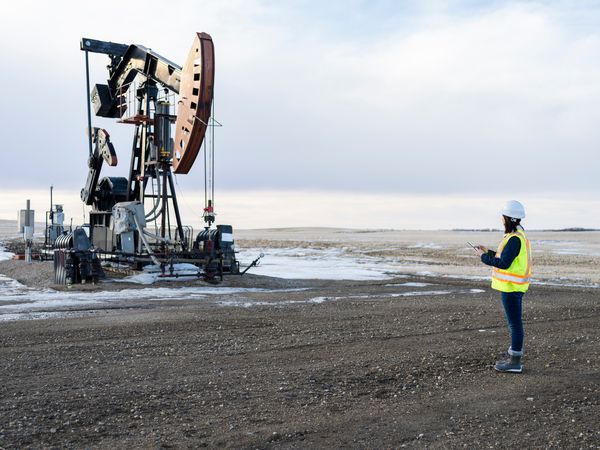Over the past several quarters, Marathon Petroleum (MPC +3.70%) has presented investors with an awfully attractive investment case. While earnings suffered a bit in 2016 and early 2017 from weak refining margins across the U.S., the company continued to churn out cash that it then gave back to investors in the form of sizable dividend increases and stock repurchase plans.
Based on its most recent investor conference call, it appears that management wants to stick to the same playbook for a while. Here are a few quotes from that call that highlight how Marathon plans to maintain its market-beating results.

Image source: Getty Images.
We're a refiner, but we're spending our money elsewhere
Marathon Petroleum's bread-and-butter business is refining. In 2017, its refining and marketing segment generated more than 58% of operating profits. Trouble is, refining in the U.S. is not a growing industry. Gasoline and diesel demand in the U.S. hasn't grown that much in the past decade, so there hasn't been much incentive to build new refineries or significantly expand capacity. That means all that cash Marathon's refining arm throws off needs to go somewhere else. That's why, according to CEO Gary Heminger, Marathon's capital spending leans heavily toward its other two business segments -- midstream and its Speedway retail network.
[T]his morning we announced our 2018 capital investment plans for both MPC and MPLX (MPLX +1.31%). This plan remains focus on strengthening the sustained earnings power of the business through growth and margin enhancing projects as well as expanding our more stable cash flow businesses especially Speedway and MPLX. Our capital plan for MPC for 2018 excluding MPLX is $1.6 billion. This plan spending includes $950 million for Refining & Marketing, $530 million for Speedway and $100 million to support corporate activities and other investments.
The critical part of that statement is that this plan excludes its investment plans for its subsidiary master limited partnership, MPLX. Here's Heminger again on MPLX's capital plan.
[I]ts capital investment plan for 2018 including $2.2 billion for organic growth and approximately 190 million for maintenance capital. This robust organic growth plan includes addition of eight processing plans representing nearly 1.5 billion cubic feet per day of incremental processing capacity as well as 100,000 barrels per day of additional fractionation capacity.
MPLX is the one section of the business that has the largest growth opportunity. With shale oil and gas booming in the U.S., there are ample opportunities to invest in transportation, logistics, and processing. MPLX is also uniquely positioned because of its assets in the Marcellus and Utica share regions in the Northeast. Unlike other shale basins that were also sources of conventional oil and gas wells, the Marcellus and Utica don't have the pipeline and processing networks needed to unlock their full potential. With billions slotted for processing capacity across these shale basins, Marathon's stake in MPLX is its largest growth outlet today.
The opportunity in refining
For all those statements about the lack of growth in gasoline and diesel demand, there are some ways that Marathon Petroleum can improve the profitability of its refining segment: exports. Heminger detailed Marathon's exports for the year.
We expect demand from export markets to remain robust. MPC continues to be well positioned to take advantage of export opportunities of both Galveston Bay and Garyville. In the fourth quarter, we exported 314,000 barrels per day or about 17% of our nameplate capacity.
Exports have historically been a great market for refiners with a heavy presence in the Gulf Coast. Not only are retail prices higher in many export markets (especially those countries without their own), but exporting ensures that refineries can run at higher utilization rates. This is important because refineries have high fixed costs, so high utilization rates spread costs across more barrels and improve margins.
The winner of the Marathon split
Back in 2011, Marathon Oil (MRO +0.00%) elected to spin off Marathon Petroleum. At the time, much of the reasoning for the split was that both entities would garner higher valuations than as an integrated company. Also, by separating them, both could best allocate capital to grow shareholder value.
Since the split, there has been a lot of value generation for shareholders, but the results have been decidedly one-sided. Heminger gave a rundown of how Marathon Petroleum has returned value to its customers.
Since MPC became a separate company in 2011, we have returned over $13 billion to shareholders. Importantly, $3.7 of that $13 billion was in the form of regular quarterly dividends which have grown by 26.5% CAGR [compounded annual growth rate] since MPC became an independent company.
With numbers like that and the current price of oil, it's hardly surprising that Marathon Petroleum shareholders have been the clear winners of the breakup.
MPC total return price data by YCharts.
Making the right move
Back in 2016, Marathon Petroleum was being pressured by an activist investor to reconsider its strategic plan for both MPLX and its Speedway retail arm, with an aim of spinning them off into wholly separate entities. The result of that review was for Marathon to sell (or drop down) any midstream-related assets at an accelerated rate and to restructure its ownership of MPLX. This past quarter, Marathon and MPLX completed the last of the transactions under this plan, and so far the plan has been well received. Here's Heminger explaining what's changed as a result of the transaction.
As part of this strategic actions, we executed dropdowns to MPLX of assets and services that are projected to generate approximately $1.4 billion of annual EBITDA adding high-quality, fee-based streams to MPLX and further diversify the partnership's earnings.
Following the dropdowns, we completed the conversion of MPC's GP economic interest in MPLX into LP units. This conversion provides a clear valuation for MPC's ownership in MPLX. This combined with the elimination of the partnerships IDR [incentive distribution rights] burden creates mutual benefits of positions MPLX extraordinarily well to deliver long-term sustainable growth for its unitholders including MPC.
Earlier this year, we're pleased to see Standard & Poor's recognized MPLX's transformation and strong credit profile by upgrading the partnership's credit rate to BBB plus.
It may sound like a small thing, but an investment-grade credit rating is a big deal for a master limited partnership. Since MLPs have to find external funding -- debt or equity issuances -- for new projects, cost of capital is a deciding factor in the viability of new assets. By obtaining an investment-grade rating, it ensures that MPLX will have more access to capital at lower rates should it need it. Also, the elimination of IDRs gets rid of a more perverse incentive structure that will ultimately benefit long-term investors. It was the definitive change to MPLX's business that led me to become a personal shareholder.
MPC total return price data by YCharts.
What a Fool believes
Marathon Petroleum has been a solid investment ever since it went public and has handily beat the market on a total-return basis. The company's ability to generate gobs of free cash flow that can get plowed into buybacks and dividends has been one of the largest factors in its performance. Based on its strategic plan, it doesn't look like that trajectory is going to change anytime soon. If investors are looking for an investment in refining, Marathon Petroleum should be high on their list.







